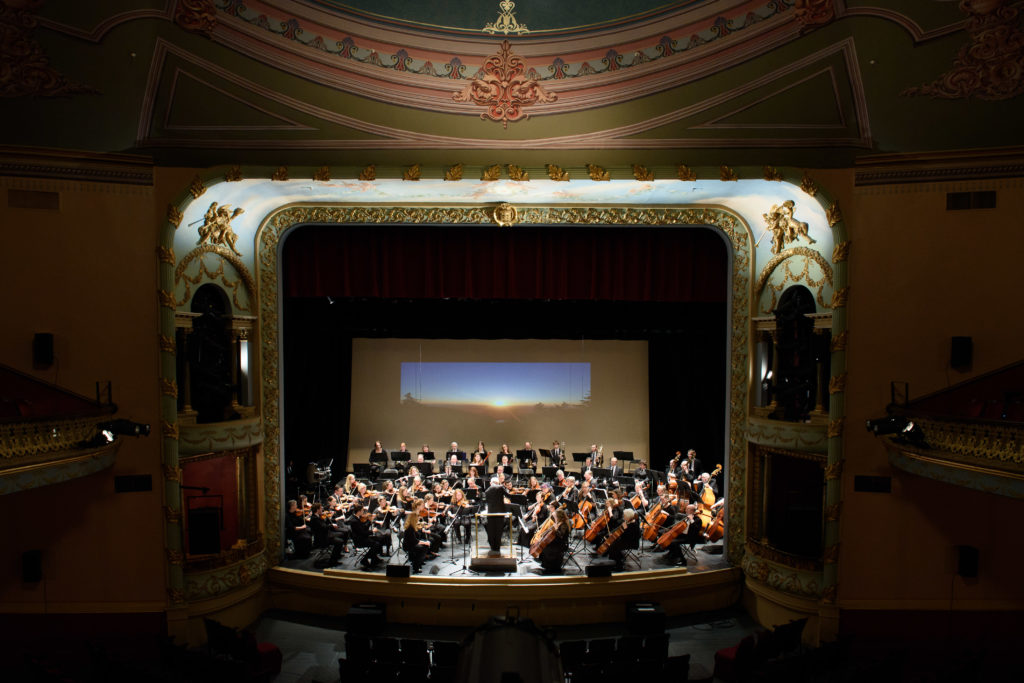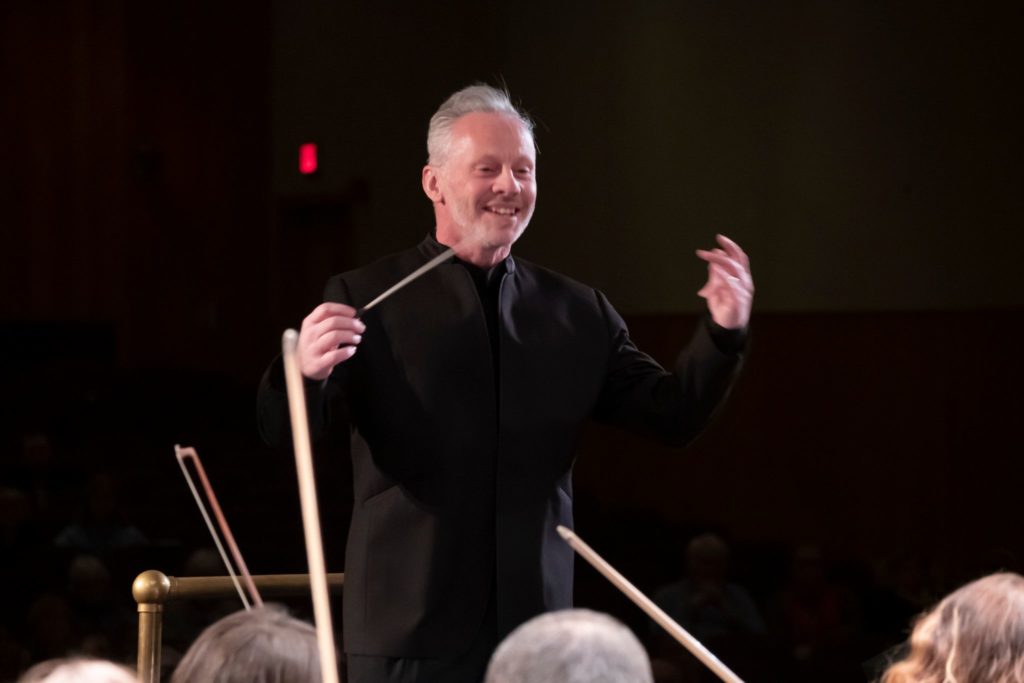Sponsors
Message from the President

As the Portsmouth Symphony Orchestra embarks on this, it’s 25th season, our mission to entertain, educate and encourage the audiences of today and tomorrow has never felt more relevant. Making and experiencing music, in all forms, is a basic human instinct. Music is what connects us across geography, cultures and time. Music consoles us and inspires us. And music is for everyone.
Here on the Seacoast, the PSO takes its responsibility to keep the tradition of high-quality classical music alive and is committed, as part of this endeavor, to giving voice to talented composers and works from the genre that are perhaps less well known to audiences. We hope you’ll find this year’s programs reflect this ongoing commitment.
Just as a symphony is only made possible by the coming together of individual musicians to create something more than the sum of its parts, so too does the PSO as an organization rely on the contributions and investment of so many. This year we are grateful to our generous corporate sponsors, our committed individual donors, our community partners, my fellow board members, our talented Music Director John Page, the musicians, and of course YOU—our dedicated and enthusiastic audience.
Whether this is your first concert, or you are an annual subscriber, we are thrilled to have you as part of the PSO family. Welcome and thank you for your continued support.
Now, on with the season.
David Young
President of the Board of Directors
Message from the Music Director

There’s a lot to be excited about during the PSO’s 25th season. This year, the orchestra will be performing a collection of deeply evocative pieces that will challenge both the musicians and the audience to explore the full range of human emotions.
As we all know, landscapes have the power to inspire us and stir different emotions and many of this year’s composers were powerfully influenced by landscapes—Mahler by the Austrian lakes and mountains, Sibelius by the dramatic landscape of Finland, and Elgar by the bucolic rolling hill of England’s Malverns. Audiences can look forward to works by these composers as well as those by Walker, Still, Beethoven, and Fung.
We’ll also welcome talented guest performers Ben DiScipio (tenor) in December and Ko-Eun Yi (pianist) in March; and, for the New Year’s Eve concert, we welcome back guest conductor Dirk Hillyer. In June, audiences will be treated to a performance by the winner of the 2023 Young Artist Competition.
We’re looking forward to making music together and are so happy you are here to share it with us.

John Page
Music Director
Program Listing
Lyric for Strings | George Walker |
Symphony No. 5 in C-Sharp MinorI. Trauermarsch | Gustav Mahler |
—Intermission— | |
Symphony No. 5 in C-Sharp MinorIII. Scherzo | Gustav Mahler |
Musicians
Violin I
- Zoia Bologovsky*
Concertmaster - Nicole Wendl**
Asst. Concertmaster - Louise Kandle
- Rachel Swanson
- Aniko Geladze
- Sargis Karapetyan
- Lorna Ellis
- Becca Bannon
- Susan Holcomb
- Jill Good
- Lisa Hollis
- Laura Sousa
Violin II
- Anna Pearlman*
Principal 2nd - Susan Streiff**
Asst. Principal 2nd - Susie Stevens
- Evelyn Laux
- Megan Fedor
- Abigail Sykes
- Kristin Sullivan
- Jeffery Sullivan
- Jim Bullock
- Nicki Payne
Viola
- Theresa Cleary*
- Karen McConomy**
- Jan Heirtzler
- Eric Salas
- Wendy Keyes
- Thalia Dain
- Maggie Chutter
- Michele Boulanger
- Brandon White
- Cello
- Gary Hodges*
- Kurt Villiard**
- Larry Veal
- Molly Goldstein
- Fay Rubin
- Monica Grady
- Anna Seda
- Zachary Larsen
Double Bass
- Scott Kiefner*
- Nate Therrien
- David Hirsch
- Jason Summerfield
- Robert Hoffman
Flute and Piccolo
- Aubrie Dionne*
- Laurel Crawford
- Brendan Ryan
- Erin Dubois
Oboe and English Horn
- Sarah Krebs*
- Amanda Doiron
- Lindsey Stein
Clarinet and Bass Clarinet
- John Ferraro*
- Santiago Baena Florez
- Katrina Veno
Bassoon and Contrabassoon
- Melissa Grady*
- Sally Merriman
- Theresa Myers
Horn
- Orlando Pandolfi*
- Remo Izzi
- Dirk Hillyer
- Susan Williams
- Gray Ferris
- Massimiliano Picca
- Kathleen Keen
Trumpet
- Adam Gallant*
- David Shepherd
- Mark Zielinski
- James Clark
Trombone
- Brandon Newbould*
- Josh Gagnon
- Phil Hyman
Tuba
- Crystal Metric*
Timpani
- Steve Cirillo*
Percussion
- Mike Williams
- Timur Rubinshteyn
Harp
- Sorana Scarlat
Perform with the PSO
The Portsmouth Symphony Orchestra seeks classical musicians in the community to audition for a place in the orchestra.
We invite all musicians, from professionals and educators to devoted amateurs and highly
accomplished students to audition for a place in the orchestra.
Up Next
Program Notes
Symphony No. 5
When Gustav Mahler died in 1911, at the age of fifty-one, his years cut short by heart disease, by most measures he had enjoyed an enviable life and career. He was respected as one of the most effective and innovative of opera conductors; his leadership of some of the world’s most admired symphony orchestras had set new artistic standards; his songs and his symphonies were beginning to enjoy a modicum of success in respected artistic circles; and he was married to one of the most attractive, talented, and vivacious women in Europe. But, that is a sadly incomplete picture. In point of fact, after ten years of leading the musical life of the world’s most important musical city, he was hounded out of his tenure as conductor of the court opera and the Vienna Philharmonic by an unrelenting anti-Semitism of unprecedented virulence. The Viennese press attacked him without mercy, lampooning his conducting gestures and attributing every putative weakness to his Jewish background. His subsequent, brief career at the Metropolitan Opera and the New York Philharmonic had soon grown stale as he succumbed to his fatal illness. Those who did not appreciate and understand his music held the majority, and he was roundly ridiculed for its general incomprehensibility, eccentricity, and wildly personal nature. His beloved little daughter, Maria, had died at the age of four from diphtheria. And, the passion of his life Alma Schindler Mahler, had repeatedly betrayed him in more than one deeply wounding fashion. Taken altogether, his life was a series of contradictions: profound successes, abysmal disappointments, and little in between. Music lovers have long taken an inordinate interest in the personal lives of composers to seek meaning in the abstract art of music—usually without success. Art lives a robust life of its own in the psyches of its creators, but in the case of Mahler, his music clearly reflects the realities of his inner being more than in almost all major composers. It’s all laid out in the score. Even in death, the hatred, incomprehension, and derision that had dogged him were still visited upon him. In the commentaries on his passing, Viennese newspapers variously characterized him as “. . . [a] Nibelung dwarf who came to power from the darkness of the pariahs . . . ,” and his music as “. . . one gigantic weed in the symphonic garden, a weed from which a new cross beam for the temple of disgusting indecency may be carved.” There was much worse.
To be sure, after his death, especially in the immediate years after World War I, his music was championed by a few determined admirers, largely from German-speaking countries, chief among them the legendary Bruno Walter, a long-time protégé. And, for a while, there were a few festivals in Europe dedicated to his music, but they were soon infrequent. The advent of the Third Reich sealed the fate of his compositions, and they disappeared from the repertoire. After the Second World War, the situation was not much better, owing to, obviously, the survival of most of the artistic establishment who had long opposed him and his music in Austria and Germany. And to be sure, the radical, avant-garde musical æsthetics of post-war Europe had little time for personal, gigantic and embarrassing artifacts of late Romanticism. Times had changed. And then, beginning around 1960—the centenary of his birth–there began a total transformation of the stature of Mahler and his music. Leonard Bernstein was, perhaps, his most ardent champion, along with Georg Solti and Bernard Haitink, all of whom recorded cycles of Mahler’s works—aided by the advent of 33rpm records (Mahler’s works are long, you know.) New, up to date, editions of his works were published, a variety of books came out, and a new spate of Mahler festivals began. Few major composers have ever languished so long in obscurity or disrepute, only to rise up and take what appears to be a permanent place in the pantheon of the great. A younger generation of musicians finds it hard to imagine a musical world in which Gustav Mahler does not stand near their center.
But, what is the real nature of his music, its style, and its creator that had elicited so much incomprehension and condemnation on the one hand, and such approbation and popularity, now? There are many legitimate answers. It’s clear that we know the man through his music, and, indeed, his was a complex personality, but so are most top-echelon artists—Bruckner and his ilk excepted. Mahler was a man driven and dominated by his overt passions, there were few middle positions that he held. Possessed of deep fears and euphoric joys, he was acutely sensitive to the virtually kaleidoscopic fashion in which the world unexpectedly imposes itself upon us. The banal and the sublime juxtaposed—pathos to bathos–are familiar tropes. A well-known story recounted by Mahler from his childhood tells of his fleeing the house in despair from a typical battle between his brutish father and his mother, only to encounter the pedestrian scene of a barrel organist grinding out the utterly banal “Du lieber Augustin (The More We Get Together).” His musical style, while not quite literally quoting familiar popular tunes, is characterized by musical motifs and themes that seem to be just that. He drew upon the commonplace, or its imitation, and used them as a musico-pyschological foil to place the listener in the purgatory of the disparity between the inner and the outer self. The sublimity and beauty of many of his slow movements is the other side—and he enjoyed interrupting one mood unexpectedly for the crashing in of the other—like his life. That accounts for some of the frequent moods of parody and burlesque. He loved passionately—life and people—but was driven by thoughts of death and its meaning, or lack thereof. And the latter was not a trivial endeavor. His library was full of difficult philosophical works on existence and its forms, and he conversed and corresponded with learned friends on the subject constantly. And while he could be the prisoner of his own irrational love, he was often blind to those who loved him deeply. He exalted humanity, but could be the cruelest of friend or musician. He once had to have a police escort home to escape a flute player, whom he had treated viciously from the podium, whose friends planned to assault him in an alley. There are places in his music in which he clearly is possessed of an irrational fear of dæmonic forces that drive him into wild reaction. These elemental forces, complexities and contradictions filtered his perceptions of the world, shaped, and informed his art. It’s all there.
He composed only symphonies, songs, and orchestral song cycles—there are no works for keyboard, chamber music, or operas. His nine completed symphonies are large works, whose length is made possible by an innate mastery of musical architecture, an extension of tonality to its limits, and a constant delay of musical and psychological resolution. His melodies, as observed above, can seem trivial—or long, spun out affairs that seemingly take forever to reach conclusion. It is not without much exaggeration when pundits observe that almost all of his music appears to be based upon marches or waltzes—powerful musical imagery from his impressionable childhood. That, and a deep love/fear of nature constitute some of the surface imagery that is found throughout his art.
His first four symphonies are often grouped together, united by the important part that vocal solos and choral sections play in them. These four symphonies are closely associated with his many song settings of the poetry of Des Knaben Wunderhorn, and are rife with folk-like melodies. But, beginning in 1901 he started work on the next three, all of which completely eschewed vocal resources, and rely instead only upon the abstraction of instruments, without the specificity of the words of a text. At this time he articulated his regret of previously providing “programs,” or specific stories or contexts for his meanings. Thenceforth, he intended that the orchestra alone would shoulder the responsibility for carrying the artistic content. He also spoke of his conscious undertaking of a new and difficult musical style. All three of these works, owing to several factors, are among the least popular and accessible of his symphonies—they can be difficult to apprehend. Symphony No. 5, the first of these three symphonies, also grouped together as “middle-period” works, was begun during the summer of 1901. He composed only during the summers (in beautiful lakeside Austrian vistas), owing to his health-threatening schedule as a conductor during the winter season. It was finished the next summer, right after his marriage to the beautiful Alma Schindler. A marriage from Hell—psychological, that is—if there ever was one. But at that time, he was beside himself with joy. However, as we shall see, that joy comes to expression in this symphony only in one well-known movement.
The first movement opens with a solo trumpet fanfare, one of the most famous in the literature, and revered by trumpet players everywhere. But it is not the inspiring call to noble deeds that most presume it to be. Rather it is perhaps one of his most characteristic uses of the commonplace to set up a parody of everyday existence, for a funeral march is what follows. Think of it as a pedestrian bugle call. This is a decidedly unusual way to begin a symphony—complete slow movements rarely do so, much less one conceived as a funeral march. After some dark brass chords from the abyss, the march tune proper begins—a solemn affair, but the careful ear will hear in the violins an occasional snatch of a bit here and there of maudlin Viennese dance hall allusions. Here again, is the typical Mahlerian juxtaposition of radically different cultural experiences. Then, soon there arrives a justly famous galvanizing moment: in Mahler’s score indications—“Suddenly faster, impassioned, wild.” Wild it is, commentators and performers alike have heard it as “hysterical screaming,” and as the voice of murderers and victims, no less. This cosmic terror—not unusual in the composer’s music—soon subsides and a bit of the opening fanfare takes us back to the sentimental salon music disguised as a funeral march. The movement proceeds to its dissolution, with the “bugle calls” marking the end.
Mahler marks the second movement as “Stormy,” and it palpably begins as such. But, typically, there soon arrives a genial broad melody in the strings, accompanied by a gentle chirping in the woodwinds. The alternation of storm and sentimental reflection continues—with the occasional little march–as Mahler, in his words, “kneads” the myriad musical possibilities of his material. And then, a magical Mahler moment, as the brass section luminously peals forth a radiant, affirmative chorale. The sonorous warmth doesn’t last long—they hardly have a chance to finish—before the storm returns. It winds down quickly, though, as various sections and soloists play the short little motive that has been so important. As quiet, isolated “rain drops” fall, the solo tuba gets the last word and the storm is over.
The third movement in symphonies is usually a dance, or dancelike one—going all the way back to the days of Haydn—and Mahler doesn’t disappoint us. This one is a graceful (mostly) waltz, and why not? It’s Vienna, after all. But, it’s a really long one, beginning cheerfully, and moving from one interesting idea to another, all of the time affording the composer ample opportunity to engage in contrapuntal textures. Unlike much of the rest of the symphony, however, the textures are often spare and open, giving us plenty of space to really hear the exposed lines. Despite its clarity and ease of listening, Mahler seemed cautious about its reception: “And audiences—heavens! How should they react to this chaos, constantly giving birth to new worlds and promptly destroying them again? What should they make of these primæval noises, this rushing, roaring, raging sea, these dancing stars, these ebbing, shimmering, gleaming waves?” This quote really tells us more about the composer’s thought process than about our own perception of the movement. There are some more serious moments as it proceeds to move through lengthy musical territory, but they’re not dark, stormy, or terror filled—just intense exploration of contrapuntal ideas where almost everyone gets an exposed opportunity to solo a bit. Finally, a recitative-like passage for various solo brasses—especially the first horn—signals the end, followed by a rush to the cadence by the whole orchestra.
And now, what is perhaps Mahler’s most well known music, the famous “Adagietto.” It is the added movement in the symphony, and gained worldwide fame for its constant use in the film, “Death in Venice” (1971). Simply put, it’s an intense love offering to Alma, written in the summer of 1902, right after their marriage. He worshiped her, and it shows eloquently, here, almost painfully so. Especially considering the checkered relationship that plagued them almost from beginning to end. He met her while she was having an affair with her music composition teacher, Alexander Zemlinsky, and he died while she was in a notorious, semi-public affair with Walter Gropius, later one of the founding fathers of modern architecture (the Bauhaus School). Mahler’s letters to her, his anguished notations in his musical scores—they’re almost embarrassing—are a testimony to his long-suffering devotion to her. But, in the moment there was happiness, even if he exaggerated it in his mind. Not only newly wed bliss, but incredible beauty—all in the music. After his death she blithely went on to collect serially other geniuses as her lovers. If the purity of the love he expressed was only in his mind, perhaps it is always so with our most intense passions. Irony was Mahler’s middle name.
After all the turmoil, stormy passions, and terror, the last movement finally arrives, and it is a cheerful affair—much to the relief of many. However, from the work’s première, this very upbeat mood has been the target of not a few critics—starting with Alma, herself—who have felt that it was a somewhat forced, and uncharacteristic way to follow all that had gone before. “How can all of that lead to a cheerful ending? It’s got to be insincere.” Be that as it may, most enjoy it that way, and after a few little bucolic solos from both the woodwinds and brass, the bustling, happy finale begins. Mahler chose a very traditional form for this last movement, a rondo—its use goes back to the early days of the symphony—and it’s merely the alternation between material that comes back from time to time in recognizable fashion, and episodes of new material. What is most likely welcome, as well, for the audience is that Mahler’s tunes and motifs are usually easy to remember and recognize. The texture is not so dense, and we can follow the composer’s counterpoint, as the main melodic elements intertwine rather like a very long, and fragmented fugue. The drive to the end is mostly constant, with sudden, short outbursts in the brass and timpani that signal brief changes in the musical territory. There’s a lot of ground to cover, but gradually we sense the growing tension underlying the end. A short, peaceful interlude of repose, featuring the woodwinds, provides a break before the serious final drive. A rhythmic sea of overlapping melodies builds, posing the question: what possible conclusion can top all this off? Mahler’s answer—and, as noted above, it was controversial from the outset—is to bring back the aborted brass chorale from the second movement. This time, over sizzling string activity, he allows it to soar out in a truly magnificent and inspiring fulfillment. After this glorious moment, nothing else is possible but a short frenzied drive home. Craftsman to the end, even in this quicksilver crash to the conclusion, Mahler alludes to the little outbursts from earlier on, and to the main ideas. Finis.
Along with moments of transcendent beauty, there has also been much that has challenged, perhaps perplexed, or even offended the listener in this monumental work. Nevertheless, it provides a convincing representation of Mahler, the man, as much as Mahler, the composer. He recognized much of his innate difficulties as both. Famously, when compared with the easy, widespread approval of the music of his friend—and rival—Richard Strauss, he simply remarked, “One day people will separate the wheat from the chaff—and when his day has passed, then my time will come.”
—Wm. E. Runyan
© 2015 William E. Runyan
https://www.runyanprogramnotes.com/gustav-mahler/symphony-no-5
Lyric for Strings
An iconic figure among black American composers who worked in the classical field, Walker excelled marvelously in difficult times for men such as he. He was a native of Washington, DC, the son of a Jamaican immigrant. The first African-American composer to win the Pulitzer Prize for Music, he was educated at some of the most prestigious American schools: Oberlin, Eastman, Curtis, and the American Conservatory, Fontainebleau. Winner of Fulbright, Guggenheim, MacDowell, Whitney, and Rockefeller fellowships, he received commissions from outstanding orchestras, including the Boston Symphony Orchestra and the New York Philharmonic. An accomplished pianist, he gave his debut recital at New York’s Town Hall, and performed Rachmaninoff’s 3rd Piano Concerto with the Philadelphia Orchestra two weeks later—an auspicious beginning of a performing career. Later, he toured Europe extensively. After receiving the first doctorate given to an African-American from the Eastman school, he taught at several universities, including the University of Colorado at Boulder. Honored, respected, and admired, he lived a long life, dying in 2018 at the age of ninety-six.
His œuvre includes over ninety compositions in most of the standard genres, but like some other composers, his very first effort was a smashing success. The String Quartet no. 1 (1946) achieved immediate recognition, and remained one of the most-performed works by a black composer. Its musical nature and subsequent history bears somewhat of a similarity to Samuel Barber’s evergreen Adagio for Strings (1936) in that both works were composed by young composers, sons of physicians in well-educated families; were originally the second (slow) movements in their respective first string quartets; and both works were recognized early on as wonderfully suited to performance by a full string orchestra. In the latter version, Walker later named his movement Lyric for Strings.
The grief imbued in this work is not only in the mind of the listener, for Walker composed it with his deep feelings for his grandmother, who had passed away the previous year. He entitled the work first, Lament, before changing the title. While as a typical young post-war composer, he naturally explored a variety of musical styles, include the avant-garde fads of the time, he remained primarily a neo-romantic—like his fellow Curtis graduate, Barber. And like Barber’s famous Adagio, Walker’s work is characterized by long spun out melodic lines that weave in and out with emotional sinuousness. But, having observed that, it is pellucidly clear that this marvelous composition is completely George Walker’s.
—Wm. E. Runyan
© 2015 William E. Runyan
https://www.runyanprogramnotes.com/george-t-walker/lyric-strings
Board of Directors
- David Young, President
- Kate Murray, Vice President
- Jeffrey Gilbert, Treasurer
- Fay Rubin, Secretary
- Lawrence Connell
- Beverly Giblin
- Melissa Grady
- Jan Heirtzler
- Josephine Lamprey
- Craig Peverly
- Eric Salas
- Donna Saunders
- Michael Schwartz
- Rachel Swanson
Staff & Volunteers
- Caroline Amport Piper, Director of Communications
- Aubrie Dionne, Director of Outreach
- Erin Dubois, Administrative Assistant
- Jan Heirtzler, Librarian
- Craig Peverly, Equipment Manager
- Rick Shepard, Personnel Manager
- Rachel Swanson, Graphic Design










